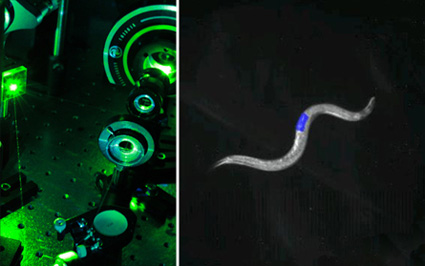We're open daily! View holiday hours
Science News
C. elegans, Biorobot
January 19, 2011

We can control your behavior and movement!
That’s not aliens speaking to humans, but rather scientists speaking to worms, Caenorhabditis elegans, to be exact.
Poor C. elegans. It’s often researchers’ favorite choice because of its optical transparency and its well-defined nervous system of exactly 302 neurons. This time two different groups are using optogenetics, a way to control cell function with light, to manipulate the worms locomotion and behavior.
A group of scientists from Harvard, the University of Pennsylvania and the University of Massachusetts Medical School have come up with CoLBeRT (Controlling Locomotion and Behavior in Real Time) that uses colored lasers to control the worm while it’s moving.
“This optical instrument allows us to commandeer the nervous system of swimming or crawling nematodes [worms] using pulses of blue and green light—no wires, no electrodes,” says Aravinthan Samuel, a professor of physics and affiliate of Harvard's Center for Brain Science. “We can activate or inactivate individual neurons or muscle cells, essentially turning the worm into a virtual biorobot.”
“If you shine blue light at a particular neuron near the front end of the worm, it perceives that as being touched and will back away,” says co-author Andrew M. Leifer, a PhD student also in Harvard's Department of Physics and Center for Brain Science. “Similarly, blue light shined at the tail end of the modified worm will prompt it to move forward.”
(A video is of this mind-control is available here.)
By stimulating neurons associated with the worm's reproductive system, they were even able to rouse the animal into secreting an egg.
A team from the Georgia Institute of Technology found that by using LCD projectors, they could also manipulate the worms’ movements. Apparently, according to Science News there are benefits to both technologies. CoLBeRT works as the worm is moving, and the Georgia Tech system has more precise targeting.
Both studies are published in the recent edition of Nature Methods. A subscription is needed to read the articles (Harvard et al and Georgia Tech), but an entire feature on optogenetics is available for free.
Image: Leifer et. al. / Nature Methods